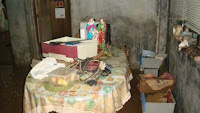 Now that Halloween is just around the corner, this would be the best time to start thinking on how to dress up your kids for trick or treating. The first thing that comes to mind to most parents is costumes. Sure your daughter looks ever so angelic in a winged fairy costume or that your son looks creepily adorable in a monster outfit, but that means finding right size that’s comfortable for them. Not to mention that you have to swipe a huge amount on your credit card.
Now that Halloween is just around the corner, this would be the best time to start thinking on how to dress up your kids for trick or treating. The first thing that comes to mind to most parents is costumes. Sure your daughter looks ever so angelic in a winged fairy costume or that your son looks creepily adorable in a monster outfit, but that means finding right size that’s comfortable for them. Not to mention that you have to swipe a huge amount on your credit card.So why not try face painting. Halloween would be the best time of the year to express that artistic instinct you were holding on to for years. W-what?! No artistic talent you say? Can’t even draw eerie stick figure representation of your family? Not even a circle and a few squiggly lines?
Naah… you don’t have to good to do face painting, you only need to have fun! It’s all about experimenting with colors and playing make believe.
 Ok, so what do you need?
Ok, so what do you need?Face Paints
These are not the same as the ones used to paint on billboards, walls, and even toys. These are water-based special cosmetic paints that are easily removed by washing down with water or even with just wet wipes. Though a number of face paints are now readily available at the toy section of malls these days, choose a brand that is non-toxic, highly tested, and safe for skin. To be on the safe side, opt for a trusted brand rather than risk rashes from breaking out. If still in doubt, apply a small amount on the inside wrist of your subject and leave for about 20 minutes to see if a reaction develops.
 Brushes and Sponges
Brushes and SpongesYou may have seen Indians in movies leave paint markings on their tribe members directly with their fingers. Though you can do the same, fingers are not absorbent and will only leave long trails of drippings wasting your precious face paint.
So your best option is to use a paint brush. Chances are, most basic face painting kit already comes with 1 soft brush included anyway. If you need to buy an extra, brushes come in all shapes and sizes. Which one to use depends on what needs to be done. A small fine pointed brush is for doing very detailed work, a medium-sized softer brush for doing bolder strokes, and a larger brush for covering up large areas.
 You may also find sponges better at filling up large areas of the face rather quickly. You are limited though to using one base color at a time as sponges takes longer to clean than paint brushes.
You may also find sponges better at filling up large areas of the face rather quickly. You are limited though to using one base color at a time as sponges takes longer to clean than paint brushes.Health Considerations
Before you begin face painting somebody’s well… face, ensure that your subject has no known skin allergies or infection whatsoever. Pimples and acnes should be avoided as well as the process of rubbing to remove the paint can cause further irritation. I doubt if anyone is willing to be painted with ths same brush and the same paint as the ones used on an acne guy (no pun intended). That being said, do not paint someone who has a contagious disease or has just come from it.
Also, never force somebody to be face painted againts their will. Violence is not an option (unless there's a big prize involved, bwa ha ha). Trick or treat!































































